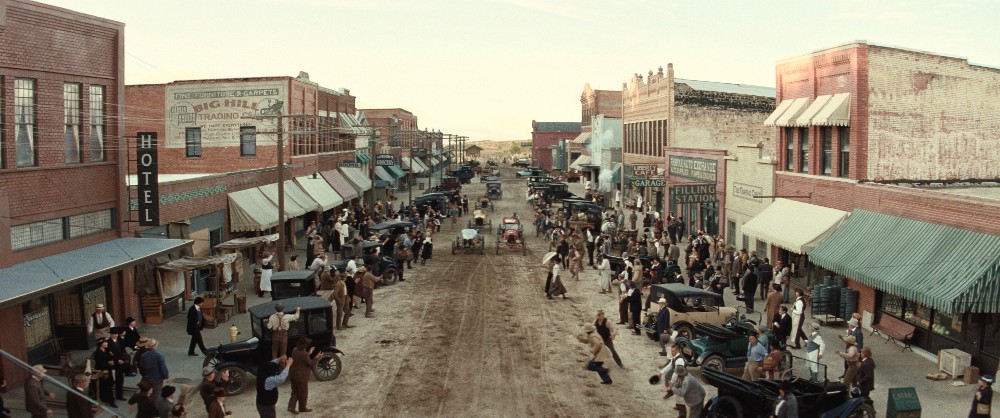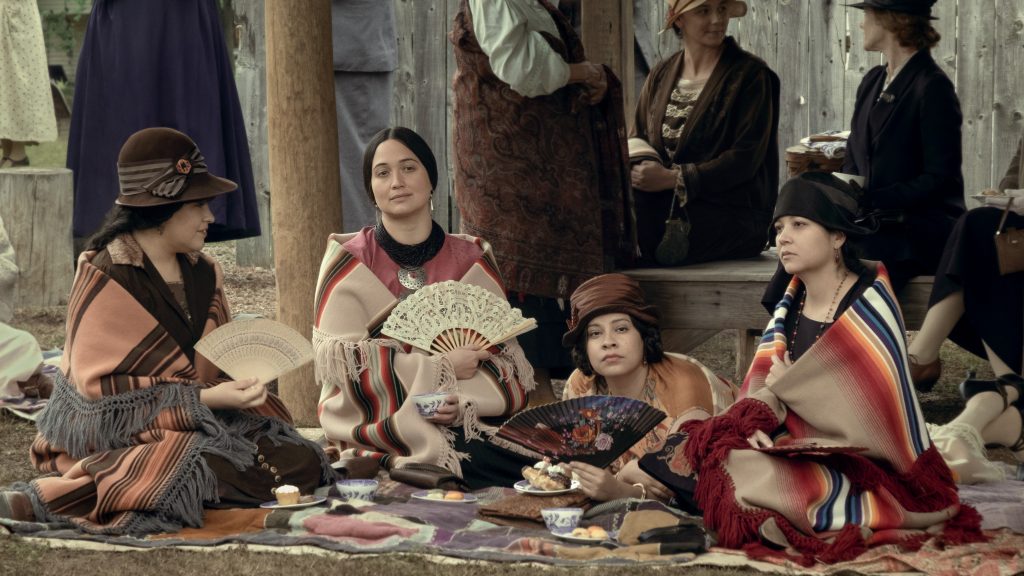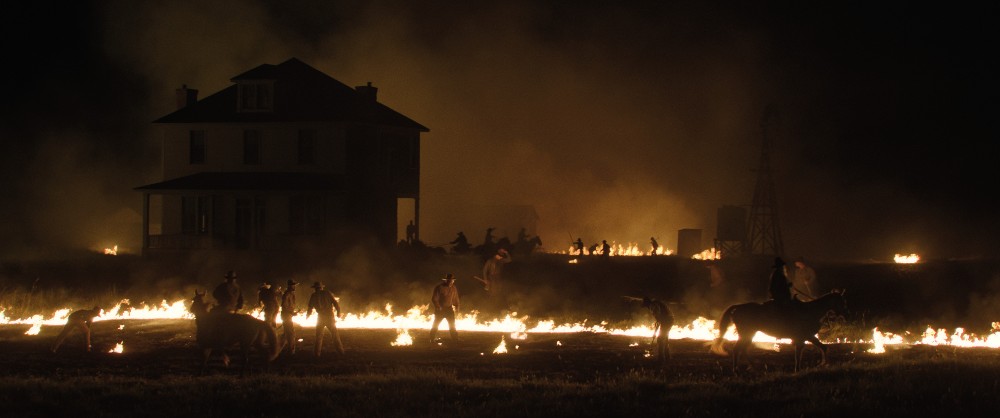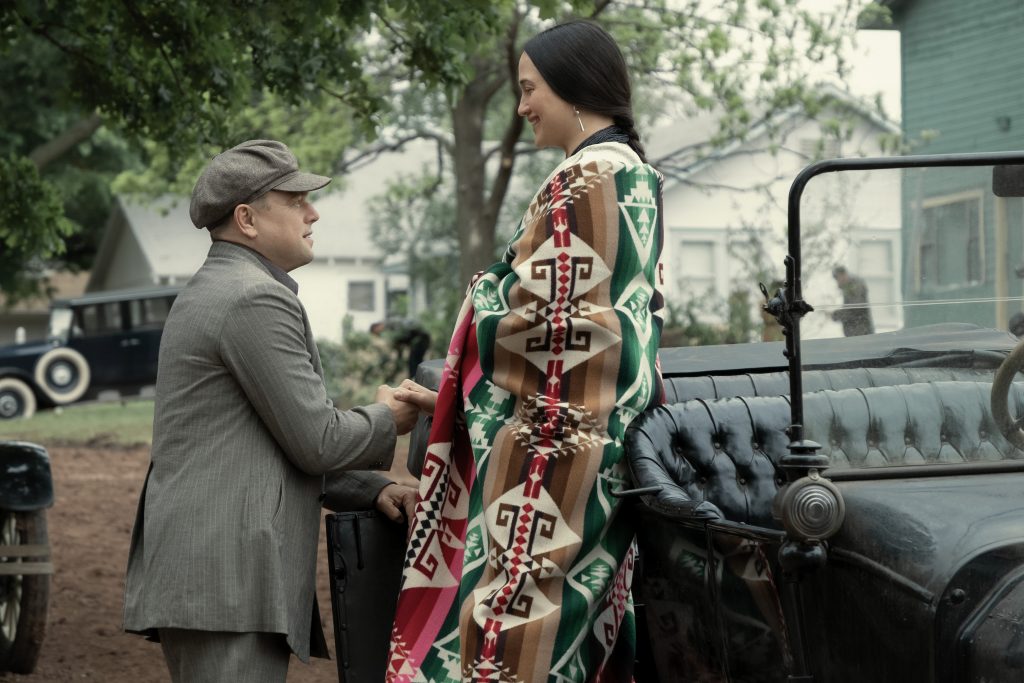Killers of the Flower Moon is a shattering vision to behold. It’s filmmaker Martin Scorsese and a long list of great artists on their A-game telling a tragedy. The film is another pure vision from Scorsese and cinematographer Rodrigo Prieto, who also shot The Irishman, Silence, and The Wolf of Wall Street.
Prieto and his filmography, including Barbie, is nothing short of awe-inspiring. Over the course of his career, he’s crafted dazzling, thought-provoking images in films such as The 25th Hour, Amores perros, Brokeback Mountain, and one epic, in particular, that caught the eye of Scorsese, Ang Lee‘s masterful Lust, Caution.
Recently, Prieto spoke with Below the Line about his most recent collaboration with Scorsese and capturing the more surreal moments in Killers of the Flower Moon.
Below the Line: Martin Scorsese first wanted to work with you because of Lust, Caution. You didn’t know why because of that movie exactly, but over the years, have you asked him?
Rodrigo Prieto: It’s very funny you’d ask that question because I was exactly thinking of asking that to Marty now. [laughs] I haven’t asked him before. I did mention it to Ang Lee recently. I told him, “Well, it was Lust, Caution that Scorsese saw that he wanted me to work with him.” The strangeness of it is that it was for Wolf of Wall Street.
It’s hard to imagine two movies that would be more different visually in the end or even the story than Lust, Caution and Wolf of Wall Street… Oh, I know. I know two that are more different, Barbie and Killers of the Flower Moon. [laughs] I guess that’s been a characteristic of my career is jumping from very different projects from one to the other. I really enjoy that.
In any case, Ang did say that he did think Lust, Caution is one of my best pieces of work in his opinion. He still loves it. He saw he saw it recently again. Anyway, so I will ask Scorsese. I’m curious about it myself, too.

BTL: It’s a fantastic movie. In Wolf of Wall Street, a lot of interiors, and in Killers of the Flower Moon, a lot of exteriors, which isn’t your favorite. How was that when you got to Oklahoma? How’d you find capturing the light there?
Prieto: Exteriors are probably the hardest thing, I think, for a cinematographer to manage because you’re always under the clock. I think cinematography, one of its characteristics is that you’re trying to create artistry, you’re trying to express emotions. You’re trying to do all these things that the artists do, but you’re very much under the clock and managing time. The nature and the sun and weather doesn’t care about that. You have to be able to still make it look like a scene happens in a specific time frame, whereas maybe you shot it during a whole day, and the weather was completely changing.
Obviously, the sun changes position, too, and you’re not controlling that. That’s a big, big challenge. Fortunately, I’d done Silence before with Scorsese. I had the experience of working with him on a movie where daytime and weather were important factors, and we worked around it. Scorsese jokes that he goes to a location and says, “What’s this green thing?” “Oh, it’s grass, Mr. Scorsese.” “Oh.” He jokes that, growing up in New York, that he doesn’t understand the sun because he was through buildings and things like that.
He is aware of it, aware of the need to manage it in filmmaking and cinematography in particular. He’s very understanding that way. Then Silence, we had moments where we started a scene, for instance, and it was a clear day, and then fog came in, a heavy fog. We reshot the scene with fog, for example, things like that. He’s willing to adapt. That’s something that we had to do on this film, as well. The light, the sunlight was an important element in our story because it’s very important for the Osage, the position of the sun, the path of the sun determines, for example, where their village is set. Let’s say the main street of a village goes east-west, for example.
The sun is very much present in their ritual and in their daily life. Every sunrise, there’s this prayer that we photographed with Molly praying towards the rising sun. It wasn’t really necessarily only an aesthetic situation or the decisions around shooting, times of day wasn’t just to make it look pretty. It was that we’re actually trying to be respectful and mindful of the Osage traditions.
For example, there is a burial in the film, and this ceremony always in the Osage culture happens right at noon when the sun is the highest position. Usually, in cinematography, you avoid that time of day because it’s not very flattering on faces. If you have to shoot at that time of day, which is very common because you have to shoot all day, many times you control it. You bring in frames of diffusion or whatever it might be, diffusion or different materials to soften some sunlight or to cover it completely and then bring electrical lighting to fake the sun. In this case, we scheduled that scene to actually be shot in the middle of the day.
That’s where I think that the story supersedes, let’s say, the aesthetic concerns of cinematography. It’s storytelling. That’s what we really do as cinematographers. The story requires us the audience to see the scene happening at noon. That’s what we do. Scorsese was very aware of all this. That’s how we just manage the time of day. With the assistant director, with Adam Sumner, we would discuss very carefully what time of day I need to shoot and what angle. We respected it as much as possible.
Then we had a lot of night scenes also, which were exteriors, which can also be extremely challenging because one of the hardest things to achieve in cinematography is believable moonlight,. It’s almost impossible for it to look believable because the moon is like the sun in the sense that it lights– it doesn’t end. The moon goes all the way in the landscape. It lights the mountains, it lights everything.
That’s where day for night comes into play. You shoot the daytime and use the sun as if it were the moon, and you do a combination of visual effects, exposure, and color timing to create the illusion of night. I did some scenes like that day for night. Others were dusk for night. We shot it that very short time period at dusk with digital cameras for that Sony Venice. Then other scenes were lit night for night. I think this movie had a little bit of everything in terms of challenges for a cinematographer like myself.

BTL: You also answered so many questions I have, thank you. As a storyteller, you’ve said a part of your job is underlining emotions. For Lily Gladstone, how’d want to underline the emotions in her performance?
Prieto: The way she approached her character was deeply respectful of the Osage, and she studied it very carefully, the language, the customs. She really embodied it. She took it very, very seriously. Herself and Leo DiCaprio would come to set with many ideas. We rewrote some of the dialogue with Scorsese, of course. Some of the scenes that are actually spoken in Osage weren’t scripted like that. Lily, she said them in Osage.
It really brought an authenticity to the whole proceedings because I am from Mexico. I live in Los Angeles, and my daughters were little when we moved. We speak in Spanglish. It’s something that feels true, feels authentic in a family like that, a mixed family like that. Also, how I grew up, my mother was American, my father Mexican, and we spoke a mixture.
Anyway, the way I approached her, for the most part, was at least the first section of the movie was very naturalistic. We used a lookup table that was simply emulated 5219 film negative. Although we did shoot with film negative, for the digital cinema, we had to have a lot to emulate the way 5219 looks on film print, on vision film print. We wanted the colors of her world to be natural. Whereas the colors of Ernest’s world and Hale were the color of the beginnings of color photography.
We created a LUT emulating autochrome, which is invented by the Lumière brothers in the beginning of this century, past century. That’s the color of the Europeans or the European descendants. When Mollie’s sister’s house explodes, from then on, we switched the LUT to a much harsher LUT, which is ENR. She’s getting sick, sicker and sicker. This LUT really gave her a much harsher look. I started lighting her in a much more dramatic way.
Eventually, they leave their home in the country, Mollie’s mother’s home, Lizzie, and they go to a house in Fairfax. Mollie is now bedridden in her bedroom. There are all these windows with shades, with yellow shades on them. I lit her with that color. I used the shades as inspiration, let’s say, or the light source. Of course, there’s light coming in through the shades, but I had other lighting to match that color.
It gives the scenes a sort of a warm but sickly feeling that later goes into a much more subjective world, which is basically Ernest, but she is also in that lighting, which is when Hale is burning his land for the insurance money.
Scorsese wanted that firelight to suddenly overwhelm everything, even though it would never arrive to Fairfax, that lighting. It was obviously very surreal in a way. Those shades that I was describing a moment ago, I backlit them with a shimmering light with– I had Mylar with 10Ks lights with different amber gels that was just shimmering, and that’s creating the firelight effect on the shades.
Even on her, when she woke up, I had some LED lights with a firelight effect on her face. Again, with this lookup table, it just becomes really, like I say, surreal, but inside their minds of Ernest and Mollie. That’s where, for me, cinematography becomes subjective and the lighting and the look, and there’s so many elements, partly the production design and obviously the acting, but we support that with lighting, and hopefully, it’ll be unsettling for the audience.

BTL: That sequence was maybe one of the more Western sequences. What staples or elements of the genre you and Martin Scorsese wanted to lean into?
Prieto: Strangely, I don’t recall any Western film that he referenced, actually. We all bring to what we do, our past experience, our lives and what we’ve seen. I’m sure that somehow seeped into the movie the Westerns that he’s seen and maybe the ones I’ve seen. It wasn’t really a conscious thought, but yes, indeed, the fire became this huge thing. In fact, when we were filming the workers trying to keep the fire in control and make sure it didn’t burn the house, we shot it, we shot the house with one wide camera, and we had two other cameras with longer lenses filming the workers.
What happened is that the lighting for the wide shot was basically the house, I put big dinos, big lighting units behind the house with a flickering effect, lighting the smoke, and that’s what silhouetted the house. The rest of it was some lighting gags, but most of it was a fire.
What happened is we had all these gas pipes hidden in different places and buried and that we strategically placed so the special effects lit those up. The tighter long lens cameras shooting through the heat waves of these fire effects created a distortion that was mesmerizing when we were filming it.
I placed underneath the lens just a small fire gag that has a little pipe with holes on it, gas and just a little fire. That created some distortion, but most of it was created by this fire that was 50 feet away from the cameras. That distortion when we were shooting it was so mesmerizing that Scorsese wanted to keep shooting and asked the choreographer to do different positions with the people. There were some even dancers, I believe, in there, stunt people, but also dancers, and they’re doing these strange positions. Again, it becomes, yes, almost surreal in every aspect. It becomes like hell is actually taking over in a way.
BTL: Another surreal, very subjective image is the oil comes from the ground, and there’s a dance and celebration. You often think of sound while composing images. For that moment, how did sound influence your choices?
Prieto: It’s true. I do think of sound and music, even though there is no music. Definitely I imagine that feeling of the strength of the earth, pushing the oil out, which in fact is unrealistic because that gush of oil only happens when you actually pump it, and you put an oil rig. Humans have to intervene for that to happen.
In actuality, if they would have found oil or when they found oil in their land, the Osage, it would have just been a bubbling puddle of oil, that’s not very dramatic. Scorsese wanted to take it to that level that’s a little surreal where this oil is raining back down on them.
We shot it with a phantom camera, I think, 700 frames per second. That’s the oil falling on them. Yes, I think that was one of the themes in the film was taking things that are real and pushing them a little bit into the surreal. Even when the owl arrives to Lizzie when she’s in her home, and it’s a foreshadowing of death, perhaps. We see the same owl later.
Mollie sees it when she’s very sick, and she’s perhaps on her route to dying. She sees the owl, and then it’s Earnest. There are all these surreal moments. All these things really came out later. They weren’t written into the script originally. It was things that Marty added, Scorsese added as the research advanced. I think the whole production was like that. It was a process that kept evolving right until the end.
Killers of the Flower Moon is now playing in theaters.






